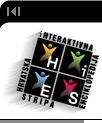
|
|
|
ZANIMLJIVO |
![[Pobijedi i osvoji nagradu!]](adds/ad-prize.gif) |


Dedicated to the all Croatian artists, and to the all who fell in love with the comic strip art
 he winds of war, understandably,
did not bypass this talented generation of comic strip creators either. Franjo Fuis lost his
life in 1943 during a war operation, while the Neugebauer brothers temporarily ceased working
on comics and engaged in experimenting with cartoon movies. Out of the entire 'first'
generation of Croatian comis strip authors, only its pioneer - Andrija Maurović - continued
doing the ninth art. he winds of war, understandably,
did not bypass this talented generation of comic strip creators either. Franjo Fuis lost his
life in 1943 during a war operation, while the Neugebauer brothers temporarily ceased working
on comics and engaged in experimenting with cartoon movies. Out of the entire 'first'
generation of Croatian comis strip authors, only its pioneer - Andrija Maurović - continued
doing the ninth art. |
 "Povratak Starog Mačka", by Andrija Maurović |
| By the end of 1945, Maurović had already published
his first postwar strip, 'Mrtvački brod', in Novi Svijet
magazine. Glas Slavonije, an Osijek magazine, ran some works
by one of the future representatives of the 'second generation' -
Borivoj Dovniković. And that was almost all. Croatia did not have a single genuine strip publication, publications of that sort being scarce in the whole of Yugoslavia, which included Croatia, at the time. |
Evil Spirits of War and Comunism ...
| began their horror dance and very soon turned on
comic strips, declaring them an undesireable element. It seemed as
though a definite end neared for the ninth art. On January 5, 1946,
the Belgrade Borba ran a very unfavorable column about the
reappearance of comics in our society. Articles, laden with the similar
connotations were soon published on the pages of other magazines as
well. In the postwar communist Yugoslavia, comics were declared
to be an undesireable phenomenon and were thus blacklisted. Immediately
following this, all existing publications came to an end, while new
comic features in certain magazines were abruptly finished off with
no special explanation. A long and tough four-year pause ensued followed by a comic revival, at fist very shy in youth magazine features, and somewhat later in specail editions. Comics were reintroduced in Croatia during 1950, thanks to who else but Andrija Maurović. |
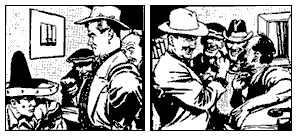 "The Mexican", by Andrija Maurović |
Right at the time when comics were making their way back into Croatia's public life, a group of authors centered around the Zagreb humor magazine on Kerempuh |
| began their pioneer work making the first
longer cartoon movie in our country.They were lead by Walter and Norbert
Neugebauer, and included Borivoj Dovniković, Vladimir Delač, Ismet
Vojevica, and Oto Reisinger. Maurović was tireless. He created 'Meksikanac'
('The Mexican', based on a book by Jack London), as well as
the historical comic strip 'Opsada' ('The Siege'), and
several western stories. The first comic books began coming out, and
Dovniković, Čukli, and Delač were joined by another four representatives
of the 'second generation': Reisinger, Bednjanec, Gotovac and the
future titan of the Croatian comic strip - Jules Radilović. |
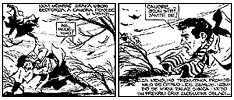 "The First Men on the Moon", by Neugebauer brothers |
In 1952, the Zagreb news agency Vjesnik started an entertainment magazine called Petko (several months before that, it started Vjesnikov zabavni tjednik, but this edition did not last very long on a market still fairly unused to comics). |
|
Petko contained new episodes of 'Gladni kralj' by the Neugebauer brothers,
new creations of Vladimir Delač, as well as Oto Reisinger's debut works. The Neugebauers published, along with reruns of old creations from Zabavnik, two strips in realistic style during 1953 - an adaptation of Wels' novel 'The First Men on the Moon' and 'Roy Thorn', a western. However, admist these domestic strip-sagas there appeared an imported one, a real masterpiece of the ninth art, 'Prince Valiant' by Hal Foster. This popular hero of American comics did not accidentaly wander into Petko, but rather as a result of well-established taste and high strip-criteria. But Petko was short-lived as well; it died after 18 months, on December 31, 1953. It was succeeded by Miki strip, which shared its sorry fate. The latter was extinguished in September of 1954. |
On October 1, 1954, "Plavi vjesnik" Appeared!
| Amongst modern researchers and critics of
the ninth art there is no disagreement about the value of the popular
Plavac - it is esteemed by all as the most significant edition
in the history of Croatian comics. For some, its greatest contribution lied in drawing together a relatively large group of domestic authors and publishing about 180 of their complete works; for others, in an extraordinarily well-established ratio between text and comic features. Some declared the graphics and art of Plavi vjesnik its greatest virtue (especially from mid-1950 on), while others regarded its choice of superb foreign comics as being most significant. Many bestowed the highest praise upon the educational role of Plavi vjesnik, upon its excellent exchange columns and reports; others pointed to its achievement in the development of the ninth art, through numerous seminars for artists, as well as great comic workshop. |
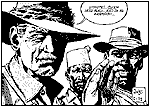 "African Adventures", by Jules Radilović |
The first issues were far from heralding the
brilliant career of Plavi vjesnik. At first it was filled by
sequels to comic strips from the aftermentioned Petko and Miki
strip. Gradually, Maurović and the Neugebauer brothers, Dovniković
and Jules Radilović (Radilović, in co-operation with textwriter Zvonimir
Furtinger, introduced the great series 'Kroz minula stoljeća').
1960 marked the beginning of Plavi vjesnik's most brilliant
period. |
|
In the next seven years this magazine did not change its, by now already fully defined,
graphics, while new features added at various points kept it fresh and up-to-date.
Eventually, a group of authors came together that would make up the very core of Croatian comics for years to come. Artists working for 'Plavac' during this period include the following: |
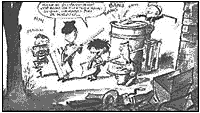 "Štefekove
pustolovine", "Štefekove
pustolovine",by Oto Reisinger |
Andrija Maurović, Walter Neugebauer, Jules
Radilović, Žarko Beker, Borivoj Dovniković, Vladimir Delač, Oto Reisinger,
Zdenko Svirčić, Norbert Neugebauer, Marcel Čukli, Zvonimir Furtinger,
Nenad Brixy, Rudi Aljinović and Mladen Bjažić. By the end of 1966,
this great bunch of authors published almost 130 complete strip-stories
in Plavi vjesnik. |
... But Everything Comes to an End
| The moment which meant the beginning of Plavi
vjesnik's downward spiral is inextricably linked to the disappearance
of a brilliant generation of domestic authors, along with three prewar
bigshots, off the stage. By the end of 1969, it seemed as though no
one was into making comics, save for the Neugebauer brothers and Jules
Radilović. Andrija Maurović withdrew into solitude and ascetism for
a number of years, sticking to it until his death. Žarko Beker turned
to graphic design, Borivoj Dovniković to television cartoons, and
Oto Reisinger continued his caricature work. Vladimir Delač died in
the beginning of 1968; Svirčić and Bjažić left comics for good, while
Furtinger, Aljinović and Čukli periodically went back to them. Out
of the entire Plavi vjesnik team, only one creator remained
- Jules Radilović. A new generation of creators was to emerge after
some years. |
| During this "barren" period, the Croatian publishing houses were preocupied with importing and publishing cheap foreign comics, completely neglecting domestic creations. The departure of the 'first' and almost entire 'second' generation left a void to be filled only by new creators; investing into an uncertain future, with dirt-cheap imported comics at hand, seemed like a totally unjustifiable venture from the economic point of view. |
"Novi kvadrat" (The "New Frame")
 'Macchu Picchu', by Radovan Devlić |
In 1976, a group of young creators, who would
later make up the core of the "New Frame", joined around the Polet
magazine. Mirko Ilić, Ninoslav Kunc, Radovan Devlić, Krešimir Zimonić,
Emir Mešić, Igor Kordej, Joško Marušić - all young men and neophythe
authors, they soon revealed their splendid talents. |
| Their role models were something else completely, and theirs creations very unique, each different from the last and the next. The "New Frame" was a means, a "pumpkin chariot", which enabled a group of very expressive individuals to step into the comic strip limelight and gave them all a chance to establish themselves and very strong, self-conscious strip authors. Today, they're all esteemed strip artists, illustrators, caricaturists, and artists. |

|
Copyright © 1995-2000 Zvonimir Tošić. All rights reserved. Hosted by cro.net |